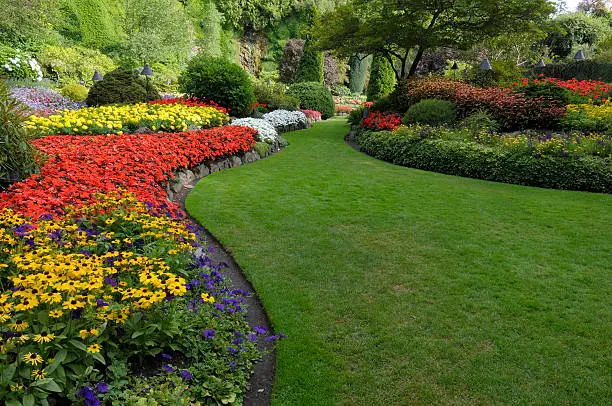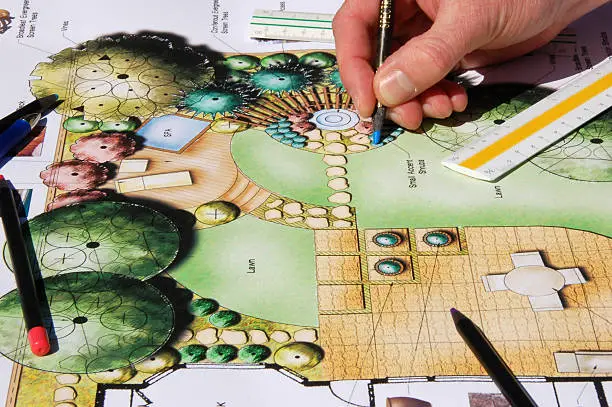Architecture and landscape architecture are two interconnected disciplines that shape the built and natural environments we inhabit.
From towering skyscrapers to sprawling parks, they work in tandem to create the spaces we live, work, and play.
While their goals may align in some aspects, they possess distinct focuses, approaches, and considerations.
Understanding the distinctions between these fields is important for appreciating their unique contributions and exploring the fascinating synergies that arise when they converge.
What is Landscape Architecture?
Landscape architecture is the art and science of designing outdoor spaces, focusing on the harmonious integration of human activities with natural and built environments.

Originating from ancient civilizations’ garden design traditions, landscape architecture has evolved into a multifaceted discipline.
Landscape architects utilize their expertise to create functional, aesthetic, and sustainable landscapes that promote social interaction, ecological health, and cultural preservation.
What is Architecture?
Architecture, on the other hand, encompasses the design and construction of built structures and environments.

It addresses the functionality, aesthetics, and cultural significance of spaces, ranging from residential dwellings to iconic landmarks.
Throughout history, architecture has undergone various stylistic movements, reflecting cultural values, technological advancements, and societal needs.
Architects play a vital role in shaping the built environment, considering factors such as spatial relationships, structural integrity, materiality, and human experience.
Related: Advantages and Disadvantages of Dog Eared Fence
4 Key Differences between Landscape Architecture and Architecture
1. Focus and Context
Landscape Architecture
Landscape architects primarily work with outdoor spaces, embracing the natural environment as an integral part of their design process.
They aim to create harmonious and sustainable landscapes that enhance the quality of life for users.
By integrating natural elements such as vegetation, water features, and topography, landscape architects create environments that promote ecological health and human well-being.
Their focus extends beyond individual structures to consider the overall context and relationship with the surrounding landscape.
Architecture
In contrast, architects focus on designing structures and interiors, considering the functional, aesthetic, and spatial requirements of buildings.
Their primary concern is creating spaces that fulfill the specific needs and desires of individual users.
Architects work with the built environment, addressing issues such as building codes, structural integrity, material selection, and spatial organization.
Their attention to detail ensures that buildings are safe, functional, and visually appealing.
2. Design Considerations
Landscape Architecture
When designing outdoor spaces, landscape architects consider various factors related to the natural environment.
They analyze the site’s topography, soil conditions, climate, and vegetation to inform their design decisions.
They also incorporate ecological principles, such as sustainable water management, biodiversity conservation, and habitat creation.
Furthermore, they prioritize the sensory experience, employing elements such as soundscapes, fragrances, and textures to engage users with the natural surroundings.

Architecture
Architects focus on the functional and aesthetic aspects of buildings.
They consider factors such as space planning, circulation, lighting, acoustics, and ventilation to optimize the usability and comfort of interior spaces.
Architectural design also takes into account cultural, historical, and social contexts, integrating elements that reflect the identity of the place or the purpose of the building.
Architects strive to create visually appealing structures that evoke emotions and convey meaning.
Related: 5 Best Ways to Move River Rock by Hand
3. Scale and Scope
Landscape Architecture
Landscape architects often engage in large-scale planning and design projects that encompass extensive outdoor areas, such as parks, campuses, waterfronts, and urban landscapes.
They approach these projects from a holistic perspective, addressing site analysis, master planning, circulation patterns, and the integration of various landscape elements.
The scale of their work allows them to shape the overall character and spatial organization of the environment.
Architecture
Architects typically focus on the micro-level detailing of individual buildings or structures.
They work with smaller, more specific spaces and pay close attention to the arrangement of rooms, interior finishes, structural systems, and architectural features.
Architects emphasize the functionality and coherence of the built environment, ensuring that spaces meet the needs of the occupants and adhere to building regulations.
4. Relationship with Users
Landscape Architecture
Landscape architects place a strong emphasis on the relationship between users and the natural environment.
They design outdoor spaces that promote public engagement, social interaction, and a sense of community.
By integrating nature into the design, landscape architects encourage people to connect with and appreciate their surroundings.
They often create gathering spaces, recreational areas, and sustainable landscapes that encourage physical activity, relaxation, and exploration.
Architecture
Architects focus on the private interactions and experiences within buildings.
They design spaces that cater to the specific needs and desires of individual users or groups.
Architects consider factors such as privacy, comfort, accessibility, and functionality, ensuring that buildings provide appropriate settings for various activities and enhance the quality of life for the occupants.
Architects also address the aesthetics of spaces, creating environments that evoke specific emotions or convey a particular atmosphere.
Related: Shadow Box Fence Vs Board on Board Fence
How Landscape Architecture and Architecture Enhance Each Other
Landscape architecture and architecture, despite their distinct focuses, often find common ground and collaborate on projects that benefit from their combined expertise.

Seamlessly Blending Indoor and Outdoor Spaces
By working together, professionals from both disciplines can create designs that promote fluid transitions between built structures and the surrounding landscape.
This integration enhances the overall user experience, blurring the distinction between interior and exterior environments and creating a sense of harmony and connection with nature.
Designing Sustainable and Resilient Spaces
Together, they can address crucial factors such as energy efficiency, water management, and ecological restoration.
By combining their expertise, they can create designs that minimize environmental impact, maximize resource efficiency, and promote long-term sustainability.
Landscape architects bring their knowledge of natural systems and ecological principles to the table, ensuring that the design incorporates strategies for biodiversity conservation, stormwater management, and sustainable vegetation.
Architects contribute their understanding of building materials, construction techniques, and energy-efficient systems, ensuring that the built environment meets the highest standards of sustainability.
Enhancing User Experience and Well-being
Landscape architects prioritize the relationship between users and the natural environment, designing outdoor spaces that encourage social interaction, physical activity, and relaxation.
They create welcoming and functional landscapes that invite people to connect with nature and foster a sense of community.
Architects, on the other hand, focus on the private interactions within buildings, addressing the needs and desires of individual users.
By collaborating with landscape architects, they can extend the benefits of the natural environment into the built spaces, integrating elements such as natural light, views, and greenery.
This integration promotes a healthier and more inspiring indoor environment, benefiting the well-being and productivity of the occupants.
Showcasing Sustainable Collaborations
Numerous successful projects demonstrate the power of collaboration between landscape architects and architects in creating sustainable and inspiring spaces.
Examples include the transformation of urban rooftops into green spaces, where landscape architecture seamlessly integrates with architectural structures, creating functional and environmentally friendly areas.
Similarly, the design of sustainable campuses, combining outdoor landscape features with energy-efficient buildings, showcases the fruitful collaboration between these disciplines.
In these projects, landscape architecture and architecture come together to create synergistic solutions that address both the functional and aesthetic aspects of the built environment.
The collaborative efforts result in spaces that promote sustainability, enhance the user experience, and contribute positively to the surrounding community.
Related
- Shadow Box Fence Pros and Cons
- Top 5 Freeman Framing Nailers Review
- Board on Board Fence Pros and Cons
- Shadow Box Fence Vs Board on Board Fence (Side by Side Comparison)


